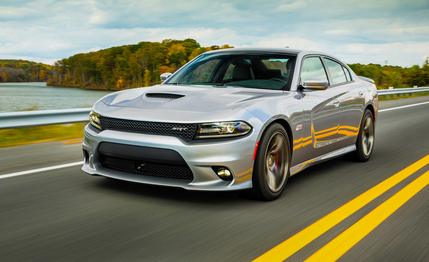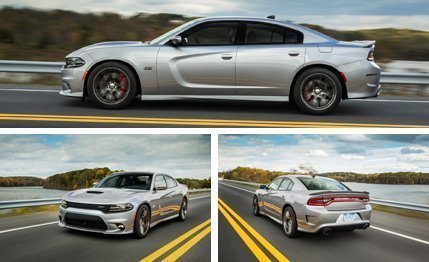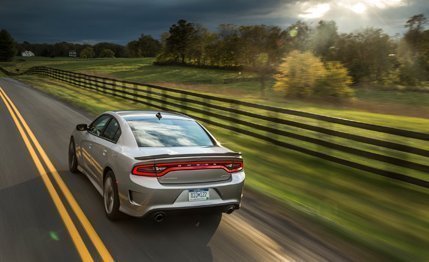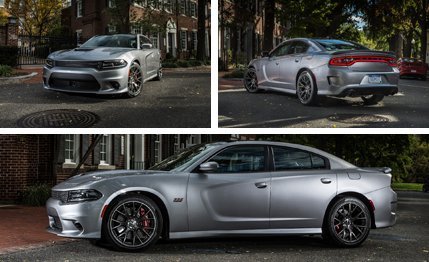 First Drive Review
First Drive Review
When Dodge took us to a hangar in Washington, D.C., and offered the keys to any of its freshened 2015 Charger sedans, we could have taken the raucous new 707-hp Charger SRT Hellcat first. But we purposely started the day in the SRT 392, somewhat afraid that we might never again be satisfied with its 485 horsepower after driving the world’s most powerful production sedan. We needn’t have worried.
It turns out that the Hellcat leaves a lot of room for fun under its long shadow, the first indication of which came when we brought to life the 392’s naturally aspirated 6.4-liter Hemi and its delicious rumble echoed through the building. No car that sounds this good can be all that bad, right?

Right. Within a mile, we were laughing hysterically, drunk on torque—some 475 lb-ft of the stuff—and bruising past less-powerful cars, which was pretty much everything that hadn’t been Hellcatted. We also wondered aloud if our licenses would survive the trip to Summit Point Motorsports Park in West Virginia, at which point we’d get to drive on the track.
Eventually, we stopped terrorizing locals, started behaving like adults, and took inventory of the experience. Steering tactility: good. Road feel: enough to communicate the surface texture, and the overly harsh default ride quality we noted in the old SRT 392’s comparison-test loss to the Chevy SS was conspicuous by its absence. Fiddling with the SRT Performance Pages functions on the center-stack screen allowed us to add weight to the steering, which was good for self-centering and muscle-building but not much else. We also dialed up the firmness of the Bilstein shocks; the Sport mode provides a little better connection to the road but the Track mode is rather too stiff for the street.
Powertrain behavior is also adjustable. It ranges from perfectly benign in Street mode to revvy, snappy, and tail-happy in Track mode. The latter ups throttle sensitivity, delivers near-instantaneous upshifts and rev-matched downshifts from the eight-speed automatic (it replaces last year’s five-speed auto), and activates very liberal stability-control parameters. Oh yeah, and it unleashes the exhaust note from hell. Or Hellcat, more accurately: The Charger SRT 392 and Hellcat share a straight-through exhaust system with electronically variable valves and an exclusive mid-muffler to give a slightly more refined sound inside the cabin than their Challenger counterparts. Dodge says there’s no impact to performance, since the back pressure is the same. And we can say the Charger is still wonderfully loud at full tilt. The SRT 392 quiets down sufficiently when cruising, however.
Also shared with the Hellcat are the SRT 392’s eyeball-ejecting brakes, which include new six-piston front Brembo calipers pinching 15.4-inch discs, up from four-piston calipers on 14.2-inch rotors on the ’14 model. The rears remain four-piston Brembo calipers with 13.8-inch discs. These were particularly appreciated when we eventually made it to Summit Point—license still in our wallet—and took to the track in both SRT models. With a 0-to-60-mph time estimated in the low-four-second range, the SRT 392 became an instant face-lift machine each time we pounced on the gas pedal.

From the outset, we knew that the SRT had zero chance of out-thrilling the ungodly Hellcat, but that didn’t stop it from being a hoot. Flat out on the front straight, the speedometer crept over 130 mph—not quite the 150 mph or so we saw in the Hellcat but still spectacularly fast for a car of this size. More remarkable was how little daylight exists between the SRT 392 and the Hellcat in terms of ultimate grip and steering feel. This latter point is notable, given that the 392’s steering is electrically boosted versus the Hellcat’s hydraulic setup. Some credit must be given to the aggressive Track mode and the grippy three-season 275/40R-20 Pirelli P Zeros worn by our test car.
That said, you never forget that you’re driving a 4400-pound full-size sedan; that’s roughly 50 pounds heavier than the 2014 model, itself no dainty petunia. The front-to-rear weight distribution is a more neutral 54/46 versus 56/44 for the Hellcat, though, yielding slightly better balance.
However portly, the steroidal Charger has never before been a nicer car in which to spend time or to look at. Much was done, says Dodge, to reduce the visual hugeness of all Charger models, starting with trimming the corners of the bumpers, dropping the height of the nose, and elongating the C-pillars. All body panels, save the roof and the rear door skins, were replaced for ’15. Both Hellcat and 392 models wear an SRT-specific nose that looks menacing and clean, as well as a wide rear bumper with outboard air extractors, a diffuser, and dual four-inch exhaust tips. The interior, likewise, is graced with upgrades that take it further upscale, and SRT models include a meaty, flat-bottom steering wheel and thick, supportive front thrones.

Like the Hellcat, the Charger SRT 392 faces little competition; the most direct contender is the aforementioned Chevrolet SS, which, at 415 horsepower and 415 lb-ft of torque, trails the Dodge by 70 ponies and 60 lb-ft but is more than 400 pounds lighter. The SS has a trump card of its own in the form of a newly available six-speed manual transmission. The Dodge’s new interior, however, could also factor into which of them is the more appealing sub-$50K supersled.
A base price of $48,380 offers 16,610 other reasons to be okay with the SRT 392 if you can’t find the scratch for a $64,990 Hellcat. The value story becomes even more interesting with the Charger R/T Scat Pack, which boasts the SRT 392’s massive 6.4-liter SRT engine and beefed-up eight-speed automatic but does without the luxe interior appointments, adjustable suspension, and hyperaggressive styling, all for $40,990. We expect to strap our test equipment to the SRT 392 soon to see how close it can get to the Hellcat’s prodigious performance, but whatever the results, this car is no mere consolation prize.